 W
WNaval artillery is artillery mounted on a warship, originally used only for naval warfare and then subsequently used for shore bombardment and anti-aircraft roles. The term generally refers to tube-launched projectile-firing weapons and excludes self-propelled projectiles such as torpedoes, rockets, and missiles and those simply dropped overboard such as depth charges and naval mines.
 W
WThe 9 O'Clock Gun is a cannon located in Vancouver, British Columbia, Canada, that is ordinarily fired daily at 21:00 (9 p.m.) PT.
 W
WThe Dutch naval gun 28 cm A No. 1, or 28 cm L/22, was the first of a few 28 cm Breechloader Krupp guns used by the Dutch navy. The 'A' stands for Achterlader, the Dutch word for Breechloader.
 W
WNaval artillery in the Age of Sail encompasses the period of roughly 1571–1862: when large, sail-powered wooden naval warships dominated the high seas, mounting a bewildering variety of different types and sizes of cannon as their main armament. By modern standards, these cannon were extremely inefficient, difficult to load, and short ranged. These characteristics, along with the handling and seamanship of the ships that mounted them, defined the environment in which the naval tactics in the Age of Sail developed.
 W
WApilan and kota mara are two Malay nautical terms which refers to the structure on a vessel where the cannon is installed. This term is used especially on Malay ships and boats.
 W
WArmor-piercing ammunition is a type of projectile designed to penetrate either body armor or vehicle armor.
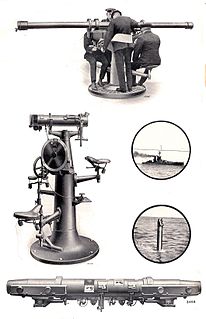 W
WBarr & Stroud Limited was a pioneering Glasgow optical engineering firm. They played a leading role in the development of modern optics, including rangefinders, for the Royal Navy and for other branches of British Armed Forces during the 20th century. There was a non-military arm of the company which made medical equipment, like photocoagulators and electronic filters, some of which were used by the BBC. The company and its intellectual property passed through Pilkington group to Thales Optronics. The Barr and Stroud name was sold on to an importer of optical equipment who use the trademarked name for a line of binoculars and similar instruments.
 W
WA broadside is the side of a ship, or more specifically the battery of cannon on one side of a warship or their coordinated fire in naval warfare, or a measurement of a warship's maximum simultaneous firepower which can be delivered upon a single target. From the 16th century until the early decades of the steamship, vessels had rows of guns set in each side of the hull. Firing all guns on one side of the ship became known as a "broadside". The cannons of 18th-century men of war were accurate only at short range, and their penetrating power mediocre, which meant that the thick hulls of wooden ships could only be pierced at short ranges. These wooden ships sailed closer and closer towards each other until cannon fire would be effective. Each tried to be the first to fire a broadside, often giving one party a decisive headstart in the battle when it crippled the other ship.
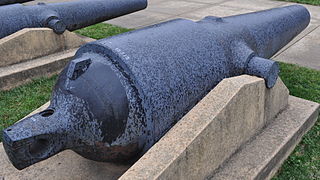 W
WThe Brooke rifle was a type of rifled, muzzle-loading naval and coast defense gun designed by John Mercer Brooke, an officer in the Confederate States Navy. They were produced by plants in Richmond, Virginia, and Selma, Alabama, between 1861 and 1865 during the American Civil War. They served afloat on Confederate ships and ashore in coast defense batteries operated by the Confederate States Army.
 W
WA built-up gun is artillery with a specially reinforced barrel. An inner tube of metal stretches within its elastic limit under the pressure of confined powder gases to transmit stress to outer cylinders that are under tension. Concentric metal cylinders or wire windings are assembled to minimize the weight required to resist the pressure of powder gases pushing a projectile out of the barrel. Built-up construction was the norm for guns mounted aboard 20th century Dreadnoughts and contemporary railway guns, coastal artillery, and siege guns through World War II.
 W
WA carronade is a short, smoothbore, cast-iron cannon which was used by the Royal Navy. It was first produced by the Carron Company, an ironworks in Falkirk, Scotland, and was used from the mid-18th century to the mid-19th century. Its main function was to serve as a powerful, short-range, anti-ship and anti-crew weapon. The technology behind the carronade was greater dimensional precision, with the shot fitting more closely in the barrel thus transmitting more of the propellant charge's energy to the projectile, allowing a lighter gun using less gunpowder to be effective. Carronades were initially found to be very successful, but they eventually disappeared as naval artillery advanced, with the introduction of rifling and consequent change in the shape of the projectile, exploding shells replacing solid shot, and naval engagements being fought at longer ranges.
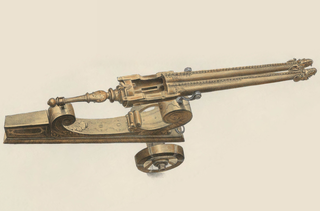 W
WThe Cetbang was a type of cannon produced and used by the Majapahit Empire (1293–1527) and other kingdoms in the Indonesian archipelago. The cetbang is a breech-loading cannon, it is different from typical European and Middle Eastern cannons, which are usually muzzleloader. In the Sekar inscription it states that the main production foundries of cetbang were in Rajekwesi, Bojonegoro, whereas the black powder was produced in Swatantra Biluluk (Lamongan).
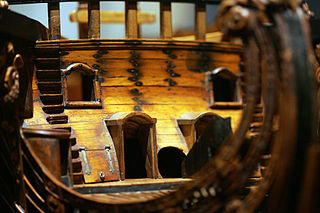 W
WA chase gun, usually distinguished as bow chaser and stern chaser was a cannon mounted in the bow or stern of a sailing ship. They were used to attempt to slow down an enemy ship either chasing (pursuing) or being chased, when the ship's broadside could not be brought to bear. Typically, the chasers were used to attempt to damage the rigging and thereby cause the target to lose performance.
 W
WA Coehorn is a lightweight mortar originally designed by Dutch military engineer Menno van Coehoorn.
 W
WThe Close Range Naval-91 is a naval version of the Medak 30mm automatic gun installed on the Sarath Infantry fighting vehicle, a variant of the Russian BMP-2 manufactured in India under license by the Ordnance Factory Medak. The Medak gun itself is based on the Russian Shipunov 2A42 30 mm automatic cannon.
 W
WA deck gun is a type of naval artillery mounted on the deck of a submarine. Most submarine deck guns were open; however, a few larger submarines placed these guns in a turret.
 W
WDriggs-Schroeder was the name of several naval guns designed by US Navy officers William H. Driggs and Seaton Schroeder for the United States Navy in the late 1880s, fitted on ships built in the 1890s. Some Driggs-Schroeder weapons were also adopted by the US Army. Driggs later founded the Driggs-Seabury Ordnance Company in 1897, in partnership with his brother Louis Labadie "L. L." Driggs and Samuel Seabury, a retired US Navy officer.
 W
WA dual-purpose gun is a naval artillery mounting designed to engage both surface and air targets.
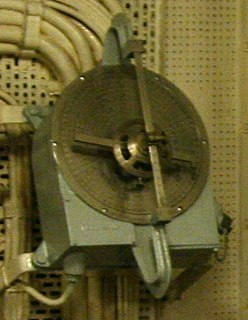 W
WThe Dumaresq is a mechanical calculating device invented around 1902 by Lieutenant John Dumaresq of the Royal Navy. It is an analogue computer that relates vital variables of the fire control problem to the movement of one's own ship and that of a target ship.
 W
WDunnite, also known as Explosive D or systematically as ammonium picrate, is an explosive developed in 1906 by US Army Major Beverly W. Dunn, who later served as the chief inspector of the Bureau of Transportation Explosives. Ammonium picrate is a salt formed by reacting picric acid and ammonia. It is chemically related to the more stable explosive trinitrotoluene (TNT).
 W
WThe Fajr-27 system is an Iranian unlicensed copy of the Italian OTO Melara 76mm naval gun.
 W
WThe falconet was a light cannon developed in the late 15th century that fired a smaller shot than the similar falcon. During the Middle Ages guns were decorated with engravings of animals, such as reptiles, birds or mythical beasts depending on their size. For example, a culverin would often feature snakes, as the handles on the early cannons were often decorated to resemble serpents. The falconet fired small yet lethal shot of similar weight and size to a bird of prey, and so was decorated with a falcon. Similarly, the musket was associated with the sparrowhawk.
 W
WA floating battery is a kind of armed watercraft, often improvised or experimental, which carries heavy armament but has few other qualities as a warship.
 W
WThe Floating Battery of Charleston Harbor was an ironclad vessel that was constructed by the Confederacy in early 1861, a few months before the American Civil War ignited. Apart from being a marvel to contemporary Charlestonians, it was a strategic naval artillery platform that took part in the bombardment of Fort Sumter on April 12 and April 13, 1861, making it the first floating battery to engage in hostilities during the Civil War.
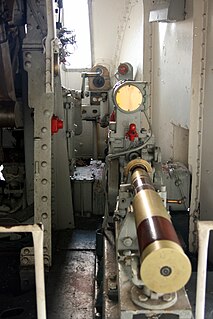 W
WThe Fuze Keeping Clock (FKC) was a simplified version of the Royal Navy's High Angle Control System analogue fire control computer. It first appeared as the FKC MkII in destroyers of the 1938 Tribal class, while later variants were used on sloops, frigates, destroyers, aircraft carriers and several cruisers. The FKC MkII was a non-tachymetric anti-aircraft fire control computer. It could accurately engage targets with a maximum speed of 250 knots.
 W
WA gunport is an opening in the side of the hull of a ship, above the waterline, which allows the muzzle of artillery pieces mounted on the gun deck to fire outside. The origin of this technology is not precisely known, but can be traced back to the late 15th century, with the appearance of artillery in naval warfare. Ships featuring gunports were said to be pierced, since the ports were cut through the hull after the construction.
 W
WHigh Angle Control System (HACS) was a British anti-aircraft fire-control system employed by the Royal Navy from 1931 onwards and used widely during World War II. HACS calculated the necessary deflection required to place an explosive shell in the location of a target flying at a known height, bearing and speed.
 W
WLantaka or rentaka was a type of bronze portable cannon or swivel gun, sometimes mounted on merchant vessels and warships in Maritime Southeast Asia. It was commonly equipped by native seafaring vessels from Indonesia, Philippines, Brunei and Malaysia. Lela and rentaka is known by the Malays as meriam kecil, the difference is that rentaka is smaller in length and bore than a lela.
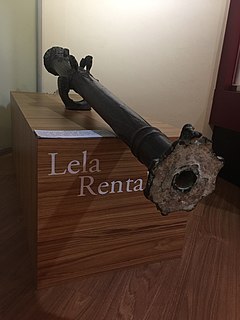 W
WLela or lila is a type of Malay cannon, used widely in the Nusantara archipelago. They are similar to a lantaka but longer and had larger bore. Lela can be configured as swivel gun, fixed gun, or mounted in a gun carriage. It is the equivalent of European falcon and falconet.
 W
WThis is the list of the Weapons used in the Philippine revolution.
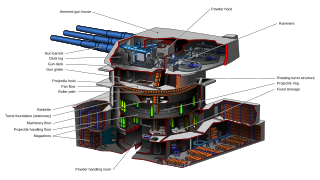 W
WA main battery is the primary weapon or group of weapons around which a warship is designed. As such, a main battery was historically a gun or group of guns, as in the broadsides of cannon on a ship of the line. Later, this came to be turreted groups of similar large-caliber naval rifles. With the evolution of technology the term has come to encompass guided missiles as a vessel's principal offensive weapon, deployed both on surface ships and submarines.
 W
WThe minion was a type of small cannon used during the Tudor period and into the late 17th century. It was of a small bore, typically 3-inch (76.2mm), and fired a 5-pound cannonball.
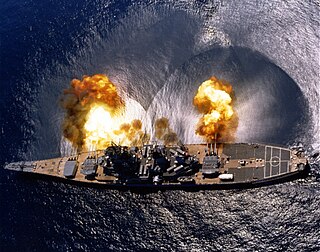 W
WNaval gunfire support (NGFS) is the use of naval artillery to provide fire support for amphibious assault and other troops operating within their range. NGFS is one of a number of disciplines encompassed by the term naval fires. Modern naval gunfire support is one of the three main components of amphibious warfare assault operations support, along with aircraft and ship-launched land-attack missiles. Shipborne guns have been used against shore defences since medieval naval warfare.
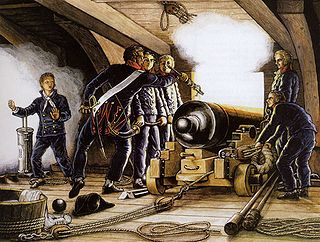 W
WIn historical naval usage, a long gun was the standard type of cannon mounted by a sailing vessel, so called to distinguish it from the much shorter carronades. The long gun was known for its increased range and improved mobility in comparison to its larger precursors. This allowed the long gun to establish itself as the best form of artillery to pursue an enemy.
 W
WPilkington is a Japanese-owned glass-manufacturing company which is based in Lathom, Lancashire, United Kingdom. In the UK it includes several legal entities and is a subsidiary of Japanese company NSG Group.
 W
WA pivot gun was a type of cannon mounted on a fixed central emplacement which permitted it to be moved through a wide horizontal arc. They were a common weapon aboard ships and in land fortifications for several centuries but became obsolete after the invention of gun turrets.
 W
WA plotting room was the co-ordination centre of a fire control system for guns used against enemy ships or aircraft, whether naval guns or coastal artillery. The plotting room received data on ship or aircraft position and motion from fire control instruments or their operators and determined and transmitted the range and bearing the guns would fire on. Plotting rooms came into use in the early 1900s for coastal artillery and during World War I for warships as gun ranges increased, and were in general use through the 1970s on World War II-era ships. Warships had plotting rooms for naval fire control for guns from 5-inch to 18-inch calibre, including anti-aircraft use for the smaller guns. On armoured ships such as battleships and cruisers, plotting rooms were located in the armoured citadel, protected by both deck and belt armour. With a few exceptions, coastal defence gun installations were inactivated shortly after World War II (US) through the middle 1950s (UK). Equipment in plotting rooms included specialised plotting boards and other analogue devices; by World War II these were supplemented or replaced by electro-mechanical gun data computers. Data could be received and transmitted by telephone, or directly via dedicated electrical systems. Locations of plotting rooms in coastal defence installations varied greatly; they could be in low-rise structures such as base end stations, taller fire control towers, in gun battery structures, or in bunkers separate from gun batteries.
 W
WThe prangi, paranki, piranki, pirangi, farangi, firingi, or firingiha was a type of cannon produced by Ottoman Empire. It was subsequently copied and produced in other place such as by Mughal empire under Babur. Prangi was a breech-loading swivel gun.
 W
WRangekeepers were electromechanical fire control computers used primarily during the early part of the 20th century. They were sophisticated analog computers whose development reached its zenith following World War II, specifically the Computer Mk 47 in the Mk 68 Gun Fire Control system. During World War II, rangekeepers directed gunfire on land, sea, and in the air. While rangekeepers were widely deployed, the most sophisticated rangekeepers were mounted on warships to direct the fire of long-range guns.
 W
WThe RML 9-inch Armstrong Gun was a rifled muzzle loading gun, used in substantial numbers by the Dutch navy, the Spanish Navy, and other navies. It should not be confused with the RML 9-inch 12-ton gun, used in the British Royal Navy.
 W
WThe saker was a medium cannon, slightly smaller than a culverin, developed during the early 16th century and often used by the English. It was named after the saker falcon, a large falconry bird native to the Middle East.
 W
WA salvo is the simultaneous discharge of artillery or firearms including the firing of guns either to hit a target or to perform a salute. As a tactic in warfare, the intent is to cripple an enemy in one blow and prevent them from fighting back.
 W
WShellite is an explosive mixture of picric acid and dinitrophenol or picric acid and hexanitrodiphenylamine in a ratio of 70/30. It was typically used as a filling in Royal Navy armour-piercing shells during the early part of the 20th century.
 W
WShip gun fire-control systems (GFCS) are analogue fire-control systems that were used aboard naval warships prior to modern electronic computerized systems, to control targeting of guns against surface ships, aircraft, and shore targets, with either optical or radar sighting. Most US ships that are destroyers or larger employed gun fire-control systems for 5-inch (127 mm) and larger guns, up to battleships, such as Iowa class.
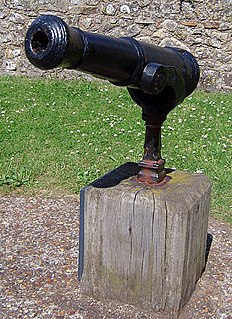 W
WThe term swivel gun usually refers to a small cannon, mounted on a swiveling stand or fork which allows a very wide arc of movement. Another type of firearm referred to as a swivel gun was an early flintlock combination gun with two barrels that rotated along their axes to allow the shooter to switch between rifled and smoothbore barrels.
 W
WThe United States battleship retirement debate was a debate among the United States Navy, Marine Corps, Congress, and independent groups over the effectiveness of naval gunfire support (NGFS) provided by Iowa-class battleships, and whether or not an alternative should be implemented. The debate centered on the best way to provide fire support for amphibious assault and other troops near a shoreline.
 W
WThe Vickers Range Clock was a clockwork device used by the Royal Navy for continuously calculating the range to an enemy ship.
 W
WThe wall gun or wall piece was a type of smoothbore firearm used in the 16th through 18th centuries by defending forces to break the advance of enemy troops. Essentially, it was a scaled-up version of the army's standard infantry musket, operating under the same principles, but with a bore of up to one-inch (25.4 mm) calibre. These weapons filled a gap in firepower between the musket and the lightest artillery pieces, such as the swivel gun. This sort of weapon may also be found described as a rampart gun, hackbut or amusette a name originally given to early medieval hand cannon.
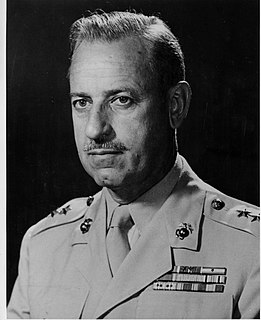 W
WDonald McPherrin Weller was a decorated officer of the United States Marine Corps with the rank of major general. He is most noted as pioneer of Naval gunfire support and author of many publications on this topic. Weller also commanded 3rd Marine Division and ended his career as deputy commander, Fleet Marine Force Pacific.